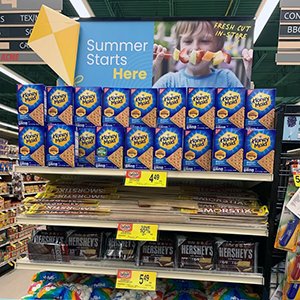How to Appeal to Shoppers’ Emotions: 10 Merchandising Pointers
According to Marketing Brainology, consumers’ buying decisions are 80% emotional and 20% logical. Here, we share how to effectively appeal to these emotional triggers and generate more impulse sales at the store level.
First, let’s consider these three factors that shed light on the importance of connecting with shoppers in today’s retail landscape:
There are 30,000 SKUs introduced every year!
Consumers are hit with 3,000 messages every day from all marketing channels
It takes just 3 seconds to make an impact in-store
So, how do brands go about the difficult task of merchandising their products in the retail environment in such a way that attracts shoppers’ attention, provides valuable information, and creates an emotional bond that will influence the purchase decision?
While the emotional appeal of a display is intangible and can be difficult to measure, a comprehensive Shopper Sense study, [engaged by POPAI] combined shopper interviews, eye-tracking, and EEG technology from over 2,000 display evaluations to understand shopper behavior. We share some of the lessons learned from the research gathered about how visuals, messaging, and placement affect purchase decisions.
10 Merchandising Strategies that Drive Sales
People’s faces, whether real or animated, empower the design, drive appeal and personal relevance to shoppers.
To make this even more personal, create an actual experience or simulate what it would be like for the shopper to use or consume the product. Example: show people thoroughly enjoying the product, make shoppers crave it!
We all know that pictures speak louder than words. Keep messages easy to digest and memorable. Information in small doses or chunks is most effective in helping shoppers decide. With information overload, shoppers lose interest - more is not better.
Items priced and signed correctly. Shoppers pay attention to price, and if prices are missing or items are not clearly marked, the shopper is most likely to pass on the product or choose another brand.
Bright, contrasting color drives attention. However, be selective in color choice so that it aligns with your brand messaging and target audience. For example, warm colors trigger impulse, and cool colors trigger a healthy feeling.
Use unique display shapes, sizes, and dimensional elements to stand out. Pointer: The Shopper Sense study found that curves on the display are shown to engage female shoppers.
Use sound, motion, and even scent technology to create an interactive and memorable display that appeals to the shopper’s senses.
A typical store aisle is 16-24 feet long, but shoppers can only absorb about 4-6 feet at a time. Create shoppable, easy-to-digest sections with a focal point. Aisle segmentation requires visual cues such as navigational signage and blade signs to create digestible segments. According to a Shop! study our eyes start at the beginning and the ends of a shelf category and work our way to the middle. Additionally, shoppers rarely ever look up once in the store aisle so the focal point should remain at eye level or below.
Products placed on the endcaps of an aisle get a 93% increase in exposure and a 32% lift in sales according to a report by Oracle Retail. Considering about 70% of grocery store purchases are unplanned, the endcap is a primary driver for impulse buys. Retailers can utilize endcaps to cross-sell items on sale and give shoppers a visual clue as to what they will find down the aisle.
Keeping displays well stocked. Even the best-looking displays fall short when they are not well stocked. Product voids lead a shopper to be less than impressed.
In a nutshell, the Shopper Sense/POPAI study revealed that the purchasing frequency correlated mostly with the attributes of the appeal and the personal relevance of the display. And, finally, when all other display attributes failed, the tipping points that influenced a purchase were to help the shopper decide and to make it easy for her/him to shop.
Orora Visual supports the retail vertical with every aspect of your in-store marketing supply chain needs: Creative Services, Structural Engineering, Print Production, and Fulfillment services.
Contact us for engaging display ideas that appeal to shoppers’ minds, hearts, and wallets!




